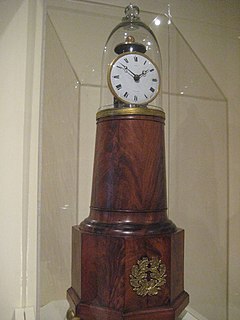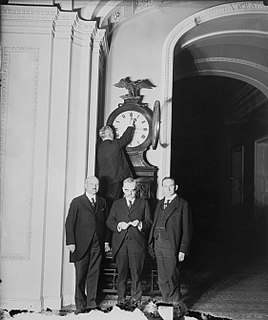Luman Watson was an early Cincinnati clockmaker. He worked in Cincinnati, Ohio from 1819 to 1834. His clocks had wooden works. He made both tall clocks and shelf clocks.
Luman Watson, son and grandson of prosperous farmers, was born at Harwinton, Connecticut, on October 10, 1790. He spent his boyhood in the center of Connecticut's clock making country, and between chores on the farm probably slipped away to follow his natural bent for mechanics. By the time he was nineteen years old, Watson had moved to Cincinnati and established the clock making partnership of Read and Watson with the Read brothers, Abner, Ezra, and Amassa. The sale of a Read and Watson clock is recorded as early as 1809 in Clark County, Ohio.
At that time there was a severe shortage of brass, American manufacturers used hardwood for making clock movements. This proved to be an adequate substitute for short duration clocks. Wheels had to have large teeth for strength so a running time of more than 30 hours was not possible.
By the 1820s eighteen workmen were employed producing first wooden and, after 1830, brass shelf clocks. The opening of the Erie Canal in 1825 however also opened the door to great numbers of cheaper Connecticut made clocks which by the time of Watson’s death had put an end to Ohio clockmaking. The Watson firm was prolific. It is estimated that between 1815 and 1834, more than 30,000 tall case clocks were manufactured. This figure is staggering considering that after about 1820 tall case clocks began to fall out of favor. By about 1830, the firm had begun making many clocks designed to sit on a mantel or special shelf.
Hiram Powers was an assistant to Luman Watson, Powers was “skilled in modelling figures... he went on to become one of America’s first great sculptors.”
Luman Watson and J. Bonsall were founders of the Ohio Mechanics Institute in 1828.
Watson died in Cincinnati November 28, 1834.
A Luman Watson tall case clock is on display in the Cincinnati Art Museum Cincinnati Wing and in the Old State Capitol in Iowa.

Lyman Beecher was a Presbyterian minister, American Temperance Society co-founder and leader, and the father of 13 children, many of whom became noted figures, including Harriet Beecher Stowe, Henry Ward Beecher, Charles Beecher, Edward Beecher, Isabella Beecher Hooker, Catharine Beecher and Thomas K. Beecher.

Hiram Powers was an American neoclassical sculptor. He was one of the first 19th-century American artists to gain an international reputation, largely based on his famous marble sculpture The Greek Slave.
A grandfather clock is a tall, freestanding, weight-driven pendulum clock with the pendulum held inside the tower or waist of the case. Clocks of this style are commonly 1.8–2.4 metres (6–8 feet) tall. The case often features elaborately carved ornamentation on the hood, which surrounds and frames the dial, or clock face. The English clockmaker William Clement is credited with the development of this form in 1670. Until the early 20th century, pendulum clocks were the world's most accurate timekeeping technology, and longcase clocks, due to their superior accuracy, served as time standards for households and businesses. Today they are kept mainly for their decorative and antique value, having been widely replaced by both analog and digital timekeeping.

Mantel clocks—or shelf clocks—are relatively small house clocks traditionally placed on the shelf, or mantel, above the fireplace. The form, first developed in France in the 1750s, can be distinguished from earlier chamber clocks of similar size due to a lack of carrying handles.

Chauncey Jerome (1793–1868) was an American clockmaker in the early 19th century. He made a fortune selling his clocks, and his business grew quickly. However, his company failed in 1856, and he died in poverty.
Simon Willard clocks were produced in Massachusetts in the towns of Grafton and Roxbury, near Boston, by Simon Willard, a celebrated U.S. clockmaker. Among his many innovations and timekeeping improvements, Simon Willard is best known for inventing the eight-day patent timepiece that came to be known as the gallery or banjo clock.

The Illinois State Capitol, located in Springfield, Illinois, houses the legislative and executive branches of the government of the U.S. state of Illinois. The current building is the sixth to serve as the capitol since Illinois was admitted to the United States in 1818. Built in the architectural styles of the French Renaissance and Italianate, it was designed by Cochrane and Garnsey, an architecture and design firm based in Chicago. Ground was broken for the new capitol on March 11, 1868, and the building was completed twenty years later for a total cost of $4.5 million.

Seth Thomas was an American clockmaker and a pioneer of mass production at his Seth Thomas Clock Company.

Eli Terry Sr. was an inventor and clockmaker in Connecticut. He received a United States patent for a shelf clock mechanism. He introduced mass production to the art of clockmaking, which made clocks affordable for the average American citizen. Terry occupies an important place in the beginnings of the development of interchangeable parts manufacturing. Terry is considered the first person in American history to actually accomplish Interchangeable parts with no government funding. Terry became one of the most accomplished mechanics in New England during the early part of the nineteenth century. The village of Terryville, Connecticut is named for his son, Eli Terry Jr.

Ansonia Clocks were made by a clock manufacturing business which started in Ansonia, Connecticut, in 1851 and which moved to Brooklyn, New York, in 1878.

Aaron Willard was an entrepreneur, an industrialist, and a designer of clocks who worked extensively at his Roxbury, Massachusetts, factory during the early years of the United States of America.

The Harriet Beecher Stowe House is a historic home in Cincinnati, Ohio which was once the residence of influential antislavery author Harriet Beecher Stowe, author of Uncle Tom's Cabin.

A lighthouse clock is a type of mantel clock manufactured in the U. S. from 1818 through 1830s by the American clockmaker Simon Willard, having the dial and works exposed beneath a glass dome on a tapered, cylindrical body.
Luman Walters is known for his connection with the family of Joseph Smith, the founder of the Latter Day Saint movement.

For thousands of years, devices have been used to measure and keep track of time. The current sexagesimal system of time measurement dates to approximately 2000 BC from the Sumerians.
The American Brass Company was an American brass manufacturing company based in Connecticut and active from 1893 to 1960. The company's predecessors were the Wolcottville Brass Company and the Ansonia Brass and Battery Company. It was the first large brass manufacturing firm in the United States, and for much of its existence was the largest brass manufacturer in the country. It was purchased by the Anaconda Copper Company in 1922, and merged into Anaconda's other brass manufacturing concerns in 1960.

Humphrey Howe Leavitt was a United States Representative from Ohio and a United States District Judge of the United States District Court for the District of Ohio and the United States District Court for the Southern District of Ohio.

The Ohio Clock is a clock in the United States Capitol. The United States Senate ordered the clock from Thomas Voigt in 1815 and it has stood in or near the Senate Chamber since 1859.
Thomas Voigt was an American clockmaker. He apprenticed under his father, Henry Voigt, an American Revolution era clockmaker and inventor 1,2,3 and became a renowned clockmaker. He built clocks that have withstood the test of time and become emblems of U. S. history and national longevity.